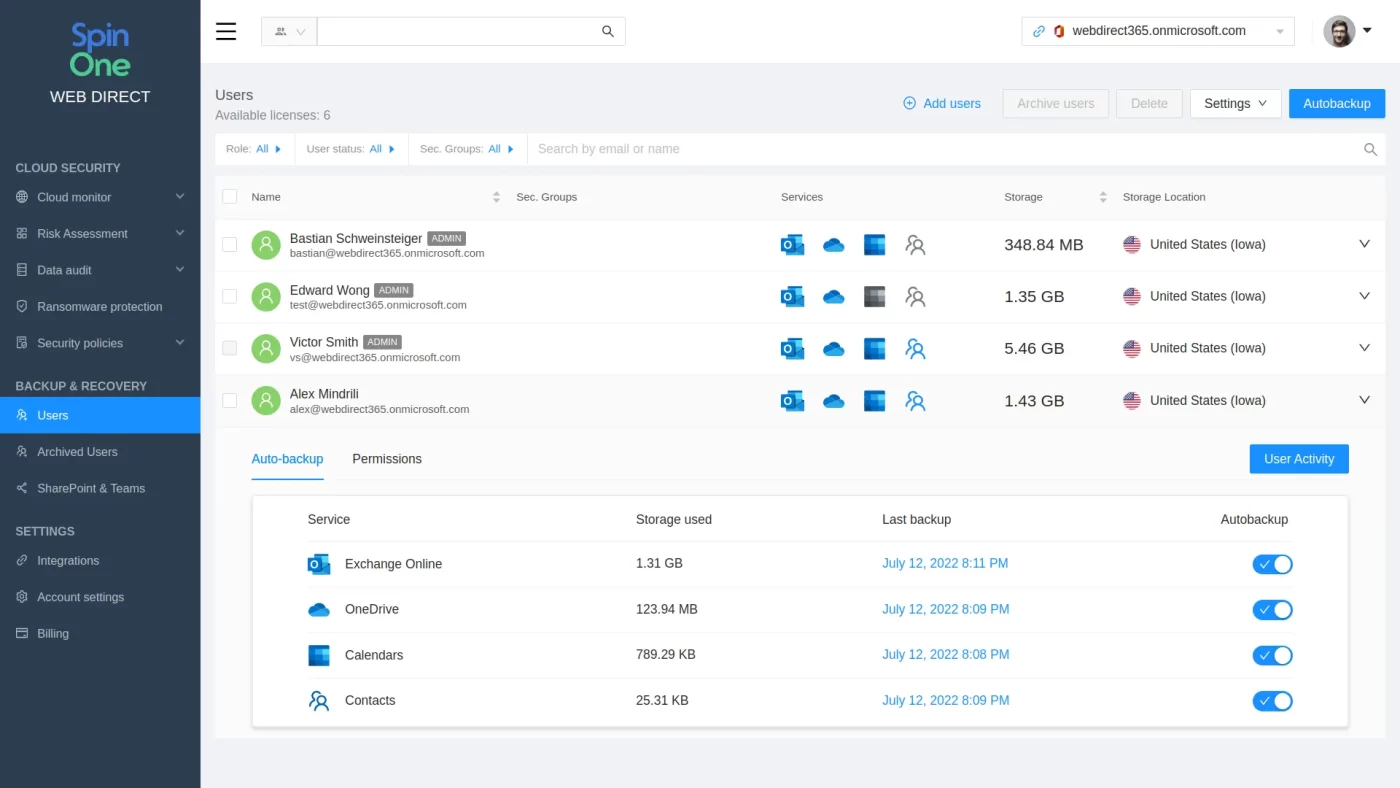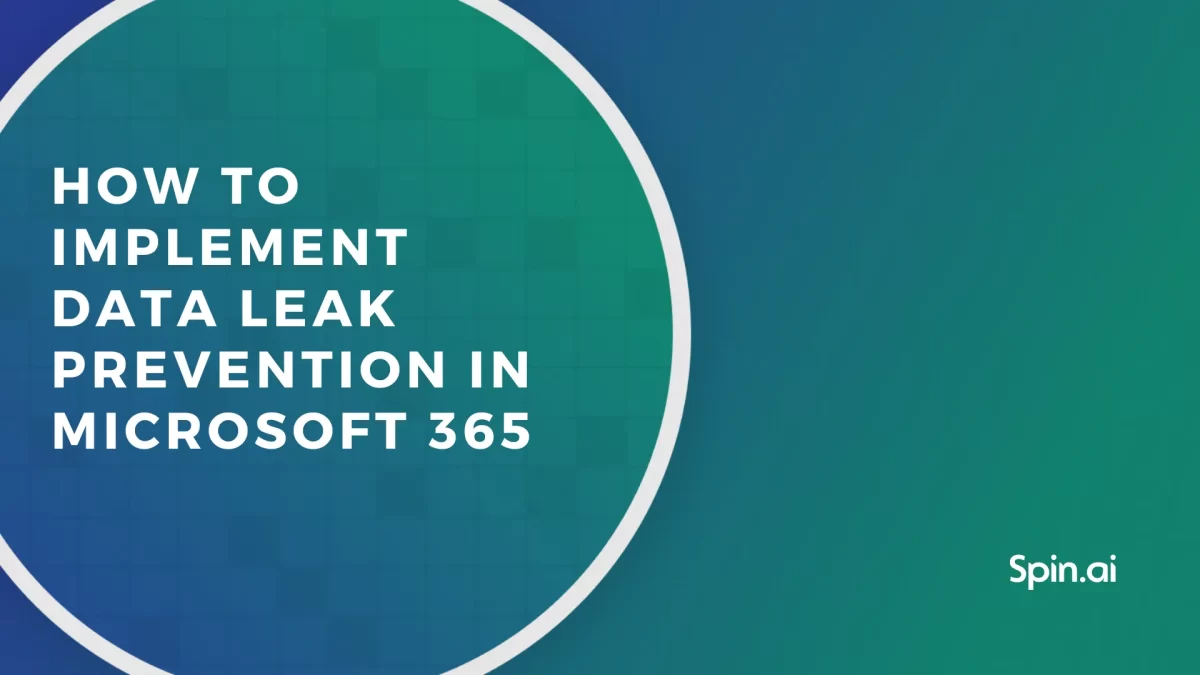How to Backup Microsoft 365: Best Cloud Tool for IT Admins

This article is for IT administrators or SMB owners looking for ways to protect their business-critical SaaS data. It explains how to backup Microsoft 365 data.
What makes the best backup tool for your M365 data? There are many factors to this, but the main ones are:
- Automation and frequency
- Recovery speed and accuracy
- Safe cloud storage (GCP, Azure, AWS)
- Ability to choose storage location
- Security and compliance of a service
- Following the best backup practices
- A user-friendly all-in-one admin panel
- Swift search and data migration features
The lack of a single feature from the list can significantly worsen your experience with a backup service and even lead to potential security breaches, data loss, or non-compliance. This list will also help you navigate the array of native and third-party backup tools for M365 data, which is not easy.
We wrote this article to help you with that. In the following passages, you’ll find out how to backup Microsoft 365 and, more specifically, what constitutes the best cloud-to-cloud backup solution. In the end, we show why our backup solution meets all the requirements and gives you even more for less money.
But before we do, we’ll briefly talk about the native M365 backup tools and why they are a hazardous option to use as your main backup. If you know this already, just skip this part.
The Problem With Native Microsoft 365 Backup Tools
According to popular belief, Microsoft cloud creates a backup of all your files automatically. It is not precisely correct.
There is no built-in backup mechanism that allows you to recover data across multiple Microsoft 365 services, like Outlook, OneDrive, and Contacts.
Microsoft says about it openly in their services agreement.
Here are the native “backup” options you have in Microsoft 365:
- The rollback option – the ability to roll back OneDrive files to a previous version, up to 30 days back.
- The restore option – the ability to restore deleted emails and files for 30 days after the deletion in the Recoverable Items folder.
If data was deleted permanently or more than 30 days ago, you can’t restore it. You also can’t recover your Contacts or Calendars.
Besides, the Microsoft 365 OneDrive data recovery mechanism relies on the same environment as production. Having backup data and production data stored together is considered to be a security flaw.
In other words, the “all eggs in one basket” approach that Microsoft 365 uses for data storage is not the most secure. Businesses relying on Microsoft’s public cloud infrastructure to store both production data and “protected” data may not recover the file version they are looking for.
Overall, Microsoft 365 native capabilities are quite limited. They may not be enough to face all Microsoft 365 security concerns. That’s why you need a third-party backup solution to secure your data from losses.
Now, break down what the ultimate backup solution for Microsoft 365 looks like.
What Do You Need From The Best Microsoft 365 Backup Solution?
The feedback we have collected from our clients points out many requirements, including:
- Backup for Microsoft 365 Services
- Granular Recovery
- Cheap data archiving
- Configurable Retention
- Cloud-to-Cloud Storage
- Versioning
- Migration Abilities
- Easy Management
- Search
- Advanced Backup Security
- Reports
Let’s explain what each of them means.
Backup for all main Microsoft 365 services
First and foremost, there is a demand for the ability to backup and recover data across all business-critical Microsoft 365 services (including Outlook, OneDrive, Calendar, People, and Teams).
Granular Recovery
Recovery functionality is essential for backup. Search for the following features:
- Point-in-time granular restoration: you can recover a single data entry from a certain day in the past.
- Recovery of data to another user: this feature will be great in case of employee leave.
- Easy and fast data discoverability in the backup: it will make your recovery faster.
Get the best OneDrive recovery software.
Cheap data archiving
When an employee leaves your organization, their data must be preserved for compliance or business continuity purposes. Keeping the employees’ Microsoft Microsoft 365 licenses active will result in massive expenses as each license costs a minimum of $8. Even with a low turnover, your company will be losing money on nothing. That’s why the backup service should have a data archiving option.
Configurable retention
Retention is a period for which your backups are kept around. An ultimate backup solution for Microsoft 365 will allow configuring retention to fit your workflow. It should be up to you to decide if pruning data after a few months or keeping data around indefinitely.
Configurable retention allows you to control the number of restore point versions that are kept to align with your needs.
Find out more about the Microsoft 365 backup retention policy →in this article.
Cloud-to-cloud storage
As we’ve mentioned before, a common practice for Microsoft 365 backup services is storing all information in one Microsoft public cloud. However, this approach relies too much on a single cloud. Diversifying data storage is the thing that is often looked for by businesses.
Cloud-to-cloud storage is the way to fully protect your Microsoft 365 data outside of the Microsoft public cloud. Cloud-to-cloud is considered to be a more advanced Microsoft 365 backup practice. It allows separating production and backup data, keeping them in different cloud environments.
The cloud-to-cloud practice is based on the 3-2-1 backup method, which encourages storing data in multiple locations and physically separated from the production data and other backups. You have at least 3 copies of your data, stored on 2 kinds of media, with at least 1 offsite storage.
This method allows you to achieve a higher level of resiliency for your backup data if Microsoft’s cloud services are undergoing a service interruption.
Versioning
It is crucial to be able to keep multiple versions of your files. The files may be altered many times, and you or your team may need to restore specific versions of them.
Migration Abilities
An effective Microsoft 365 data protection solution is one that allows migrating data. As covered earlier, migrating user data allows keeping the Microsoft 365 user number at a cost-effective level.
Keeping inactive users around increases subscription costs. Migrating user data from one account to another allows businesses to remove stale user accounts of former employees.
Easy Management
No matter how fully-featured a solution may be, being user-friendly is a must. You and your employees should be able to easily and quickly navigate the admin panel. A Microsoft 365 backup solution must be easy to operate. All available backup and recovery mechanisms should be found in a single-pane-of-glass interface. Otherwise, the use of backup would be too difficult and less effective.
Search
Imagine an organization with hundreds or thousands of employees. The amount of data is tremendous. Even for small businesses with 10-50 employees, finding a specific item across the entire data landscape may be difficult. Having a built-in search means will help you to find items contained in backups. This option makes managing restore operations less time-consuming.
Advanced Backup Security
Security in today’s complex ecosystems should be a top priority. Security is often highlighted as an essential backup feature, as backup itself is a security measure.
To provide an ultimate Microsoft 365 backup solution, Microsoft 365 backup data security must be of paramount importance. Encrypting data both in transit and at rest are vital characteristic of a fully-featured, well-designed Microsoft 365 backup solution.
Reports
You need to keep an eye on the backed-up data. That’s obvious. Having regular reports is, perhaps, the best way to stay up-to-date.
Monitoring your protected data is a key requirement to maintain visibility on potential data protection issues. That’s why a fully-featured and capable backup solution should have a reporting system.
Related Link: How to Recover Deleted Emails in Outlook
Spinbackup: Why Is It the Best Cloud-to-Cloud Microsoft 365 Backup Solution?
Spinbackup is a secure cloud-to-cloud backup solution for Microsoft 365 Google Workspace, Slack, and Salesforce platforms. We backup Outlook, OneDrive, Calendar, and People to secure cloud storage at AWS, Azure, GCP, or their own data center across the USA, Europe, Asia, and Australia.
Now let’s take a look at Spinbackup Microsoft 365 Backup and Recovery features:
- Backup & Restore for Microsoft 365 Services
- Configurable Retention
- Cloud-to-Cloud Storage
- Cost-Effective Data Archiving
- Migration Abilities
- Admin Panel for Easy Management
- Search
- Top-Level Encryption for Advanced Backup Security
- Reports
Backup & Restore for Microsoft 365 Services
Spinbackup provides an automated process to keep your Microsoft 365 data protected. The backups provided with Spinbackup are fully automated to keep your Microsoft 365 data protected 24×7. You also get daily versioning backup and secure cloud storage.
Spinbackup allows restoring Microsoft 365 backups using the same folder hierarchy as in the original, with 100% accuracy. The restore process enables you to recover the lost data. Microsoft 365 Backup & Restore is a powerful protection against data loss.
Configurable Retention
With Spinbackup, you can customize retention according to your needs. Just click Settings and set retention time (you can choose the indefinite option as well).
Cloud-to-Cloud Backup
With cloud-to-cloud Spinbackup’s solution, you can store the data backups outside of the Microsoft 365 public cloud. Besides, you can choose the data location yourself.
You can choose to store Microsoft 365 backups in either Google Compute Storage, Microsoft Azure, Amazon AWS S3, or the storage of your choosing, effectively separating the Microsoft 365 production data from the backup data. It is possible to choose because Spinbackup is an official partner of Google Cloud and an advanced technology partner of Amazon Web Services.
Cost-Efficient Data Preservation/Archiving
When you offboard your employees, you can archive their data using Spinbackup’s archived user account for only $1.80/month per user. It will save you tremendous money on archived data, especially if you have a lot of users. Especially if we’re talking about E5 subscriptions that cost $35 per month. Also, our archived accounts have the same search and recovery functionality as our backup accounts.
Ready to backup your data with Spinbackup?
Migration Abilities
Spinbackup provides the ability to migrate user data between accounts. The migration will help you keep the Microsoft 365 user count limited to active employees and eliminate the need to maintain user accounts solely for the data.
Admin Panel for Easy Management
Within the Spinbackup interface, administrators have a fast and easy search for backed-up items that quickly find them.
Spinbackup’s admin panel is incredibly intuitive and allows you an interface to manage users, backup options, and more. The Panel makes your backup management much easier.

Search
Another feature to make data management more comfortable for you is Search. With the Spinbackup interface, admins get a fast and easy search for backed-up items.
Top-Level Encryption for Advanced Backup Security
Backups of Microsoft 365 SaaS data are encrypted using the highest encryption methods for transferring in-transit and storing at-rest data. Spinbackup meets the latest compliance regulations, including SOC2 and GDPR.
Spinbackup helps organizations meet the challenge of having a robust data protection solution for the Microsoft 365 public cloud. The enterprise-level security provides capabilities far beyond what the default Microsoft 365 backup does.
Reports
With Spinbackup, you get weekly & monthly reports that allow monitoring the status of your protected data in the Microsoft 365 environment. The feature will help you to track your data efficiently and identify problem areas. You can choose if the reports you get would be weekly or monthly.
To sum up, Spinbackup provides all the characteristics of a fully-featured, enterprise-ready data protection solution that will help you to keep your data secure. With attention to our client’s needs, we made the interface as easy to use as possible, stocking it up with several time-saving measures.
By delivering automated cloud-to-cloud backups, restore capability, migration, reports, intuitive administration, and much more, Spinbackup can serve as an excellent alternative to Microsoft 365 native recovery.
How to Backup Microsoft 365 with Spinbackup
Let’s see what the backup process looks like in Spinbackup.
- Sign up for Microsoft 365 Backup and Recovery.
- Done! With Spinbackup, your Microsoft 365 data is secure now. Use your Microsoft/Spinbackup credentials to sign in here: https://so.spin.ai.
- Now let’s check the interface. On your Dashboard, you can see information about Backup and Users. Also, there is a chart showing the time of recent backups. Now click Settings.
- You can access the panel with various Microsoft 365 services. For example, select Outlook.
- You can see your Outlook information here. You can click Backup to back up your information whenever you wish. Click Restore to recover your data if needed. Click Download to download data to your computer. Other services have a similar process. Simple, isn’t it?
Was this helpful?
How Can You Maximize SaaS Security Benefits?
Let's get started with a live demo
Latest blog posts
Microsoft 365 Security Best Practices and Recommendations 2024
February 9, 2024Micorosft 365 is a business-critical cloud environment that contains terabytes of sensitive information. Protecting this... Read more
What data can be backed up from Microsoft 365?
January 5, 2024Microsoft 365 services contain business-critical data. However, none of the services has an in-built backup... Read more
How to Implement Data Leak Prevention in Microsoft 365
November 10, 2023Microsoft 365 Office Suite contains business-critical information. Despite the company’s powerful security measures, data leak... Read more


